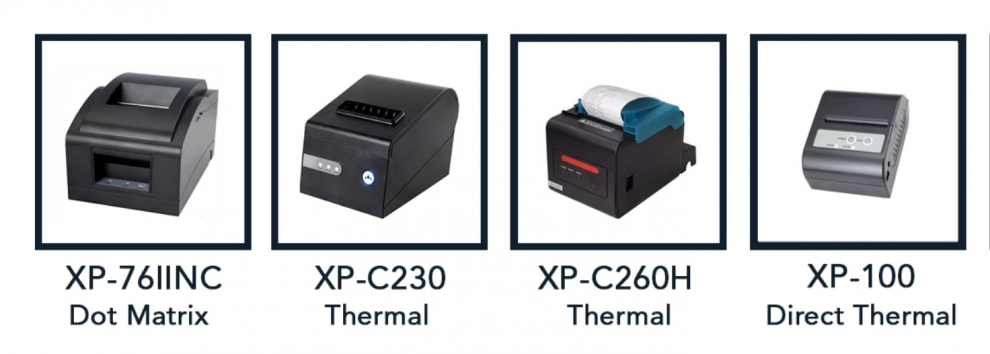The difference between thermal receipt printers and dot matrix printers are in storage time, paper quality, and printing speed. We come across lots of receipts in everyday life. These include courier receipts to restaurant receipts, shopping receipts. Both thermal and dot matrix printing techniques can achieve the same outcome. Notes that are smoother to the touch are basically made using thermal printing. Here is more info about these two printing methods so you can make the best possible choice.
Thermal Printing Facts
Thermal printing involves a semiconductor heating element that is fixed to the print head. This heats up and touches the thermal paper to generate the pattern desired, much like a thermal fax. The printer generates an image by heating up to produce a chemical reaction. It is much faster than a dot matrix printer because the paper of the thermal printer can reach the maximum speed due to the wide design of the print head.
Thermal printing is not without its downsides. The high heat can compromise the integrity of the thermal paper, so the printed receipts can’t be stored for very long. What is more, they get faded and blurred in about three months.
Dot Matrix Printing Facts
These printer types create a font by processing paper or other material using a needle in the print head. You can choose multiple sheets according to your needs. Usually, there are two or more copies. The head needle hits the material and the force of the needle is transmitted to it through the ribbon. This is how multi-copy paper is printed. The printed document is hard to forge because of the subtle differences in the needles.
One disadvantage of pin printing is low printing speed due to the reciprocating motion of the needle. You need to replace the ribbon of the dot matrix printer often. The operation is cumbersome and the printing cost is not insignificant. Common applications of dot matrix printing are invoice and ticket printing.
What is the Future of Printing?
With the advent of thermal printers to POS applications, we’re beginning to wonder if they are going to replace dot matrices completely. The compact size, speed, and reliability of thermal printers render them indispensible in terms of the requirements of certain POS systems. However, a dot matrix printer can still perform well enough in many POS systems to be used instead of a thermal model.
Dot matrix printers have perks in applications that require multiple copies, such as credit card verification. Multiple copies are also crucial to gaming applications. There is a legal requirement to keep a journal of all transactions. To these and such applications, dot matrix printers are better suited as they are designed with a matrix mechanism that applies pressure to print. This way there’s no extra wear on the mechanism when second copies are printed, and what’s more, these are clearly printed.
The thermal process is not optimal for multiple copies. Two separate receipts must be printed if a thermal printer is used. This process uses more paper and exerts additional pressure on the mechanism, which adversely affects its cost effectiveness.
Factors to Consider
When trying to choose between a thermal or dot matrix model, paper is also a determining factor, particularly in high heat applications. Restaurant businesses are a typical example. The heavier stock of the paper used with a dot matrix printer is beneficial because it survives the high heat in a kitchen. In addition, ink is absorbed quicker by regular paper. This reduces smudging and fading. Under very high temperature, a thermal printer’s thin paper stock will smear and wilt.
Dot matrix printers also differ from thermal ones in the printing process. The former uses ink to print, while the latter uses etching. Ink is preferable in restaurants, where cooks and other staff with greasy hands touch receipts constantly, because it doesn’t smear.
Thermal Offers a Smaller Footprint
Modern day POS systems prefer thermal printers because they’re fast and offer a smaller footprint. Dot matrix printers print at speeds of 3-5 lines per second, while thermal ones print up to 47 lines per second. Dot matrix printers also tend to be bigger, especially in their depth. They’re also a lot noisier. This feature is crucial in upscale POS applications, such as high-end department stores, fine restaurants, boutiques, and more.
If the dot matrix printer is visible, having it loudly print a receipt wouldn’t be in line with high-end retailers’ image. Noise is always a factor unless your printer is in the back.
Graphics capability is becoming crucial to today’s receipts. Logos, barcodes, and other graphics can be printed with both thermal and dot matrix printers, but they usually look better when printed with the former. Etching is more conducive to such printing. The thermal printer’s enhanced graphics capability is important in applications where branding and corporate image are factors.
Thermal printers can be designed into more sophisticated applications because they are more advanced technologically. In gaming and other applications, this technology eliminates the need to print more than one copy of the same receipt. The report and log can be printed out at intervals of choice, ex. daily, weekly, or monthly. They can be used as backup instead of printing multiple copies.
More Reliable
Thermal printers are more reliable. A dot matrix printer has a print head that moves from side to side, a mechanism that drives the paper, and a replaceable ribbon. It suffers a great deal more wear and tear as a result. Normally, you won’t need to replace the head of a thermal model before it has printed 30 million characters, while a dot matrix model requires a ribbon change after printing from 300,000 to one million characters.
Conclusion
Obviously your choice between a dot matrix and a thermal printer should depend on the application. If you are choosing a thermal printer just because it is a newer technology, you might find yourself changing the printer soon. This is because technology is evolving at the speed of light and printers will continue to evolve as part of this.







